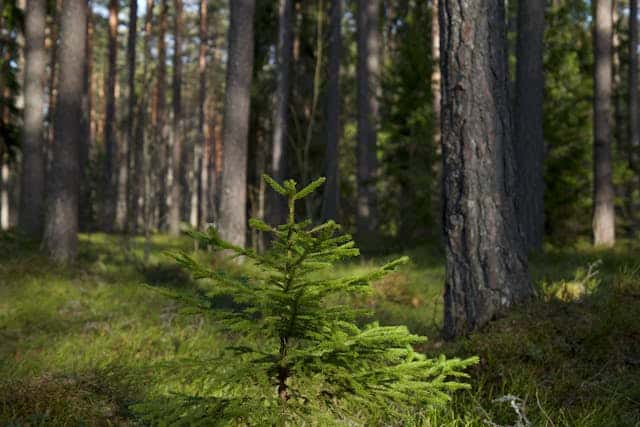Lifelong Lessons of Sustainability
From the beginning, my sister and I were taught a sustainable lifestyle by our parents. As a young boy, I was introduced to the one-to-one ratio of living and resources by how we approached our daily life. We heated our own hot water on a tank attached to our wood stove until I was 16, had a large garden with which we canned and preserved vegetables for winter, our sugar was honey from our bees or maple sugar from the trees, meat came from animals we raised or hunted, and our heat was from the wood we procured each year. This way of life was hard in some respects, but was crucial to my foundation as a person as it developed my understanding of the vast resources it takes to make a living. Since this was the way we lived our lives day to day, it was also the way my parents ran Carlisle at the time — every piece of the wide pine boards was utilized in some fashion.
With these qualities instilled in me, I began the journey of working with my parent’s small wide pine flooring business and built it into a large, widely-known plank flooring company known as Carlisle Wide Plank Floors. Over twenty years later today, with my new company William and Henry Wide Plank Floors, we continue on with these same values, same wood, and the long history as the paramount founders of traditional, wide plank flooring. We also continue to carry the belief that our human resources at our company are by far the most critical to our success. Ensuring that everyone has a sustainable way of life and shares in our successes from all of our collective efforts helps to fulfill our vision of using all of our resources responsibly and positively. As the old saying goes “waste not, want not”.
Our Sustainable Approach
The trees we use in making a wide plank floor are older, well into their maturity and old growth stages. It’s always been a mission of mine to add value to the tree lifecycle instead of taking away from it, pushing land owners to let their trees mature to create a self-sustaining cycle. This mission all ties back to my dad’s original passion, as he loved history and early American architecture and was driven to create the aura of a wide, old growth board in all of the homes he built. If you let a tree mature into its later years, you work within the natural cycle that has sustained our forests for thousands of years. It was only in the times of mass production of narrow flooring, or “strip” flooring, that our forests paid dearly as there was no orientation towards the width of the board, like there was historically. Therefore, there was very little care or acknowledgement of what this mass production was doing to the tree lifecycle and our forests.
As we harvest the older, more mature trees, the genes of these magnificent trees have been spread yearly from its seeds throughout the forest thanks to natural reforestation. On average, the trees we use are approaching a range in the age of 80-120 years, so you can only imagine that vast amount of reforestation these trees have contributed to our forests. These genes are the best from thousands of years of genetic improvement to develop the best, most steadfast tree that can grow there from the soil and nutrients of that specific spot in the forest.
With natural reforestation, it’s important to note that we are preserving the trees in many forms of use in society now. We are maximizing their utilitarian use and preserving the life they’ve lived instead of letting them enter a lengthy decaying process in which the life benefits of the tree are vastly diminished.
The Final Touches
After selected, our trees are brought to a sawmill, typically a small one that’s been around for generations, where they will process the logs as an art form and preserve the beauty from the log into flooring. The small sawmills are more likely to be able to take time to work with these logs to preserve their beauty for our customers, and they take pride in doing so, while larger mills are mainly for mass production of commodity wood products. For many individuals, this passion for wide plank floors is generational and rooted in the art form of maintaining the natural beauty of the logs.
By bringing business to smaller sawmills, we are sustaining their generational businesses, securing the jobs of loggers and log truck drivers in our communities, and sustaining the artful craft of wide plank floors in the process. This was the process we used with Carlise Wide Plank Floors, and is it the same one we now use for William & Henry because these small mills take great pride in how they saw the log, dry the wood, and maintain the artful nature of the wood to be appreciated in the future floors it will be part of.
Once the lumber reaches William and Henry Wide Plank Floors, the final stage begins to turn the lumber into our floors – three quarters of which is done with solar-produced energy. Our team ensures every inch of every piece of wood is used — the sawdust goes into containers of various use, whether it be horse bedding shaving from pine or sawdust for heat generation, and the scraps and defects from each piece are all utilized for a purpose of sustenance.
The final result? A wide plank floor produced to match a certain vision of our clients — one where each plank is flipped to find the best “face” or story of the tree as we see it. After doing this for over twenty years, no part of our process is rushed we make every decision with sustainability and social impact in mind. If we work within the lifecycle of nature, the self sustaining properties are immense and so is the quality of the end result we are left with. But the sustainability of our work goes past just the forest. Our work helps to provide that logger out in the woods, the truck drivers transporting the logs, and the craftsmen at the mills the ability to put food on the table for their family — that should make anyone feel good.
Every individual involved in this process, from the individuals selecting the trees in the forest to the sawmill workers, are happy and take pride in this work we do. No matter what stage of life they may be in, they are all supportive of each other like a family, and this can be seen in everything we do as a company.
Generational Impact
By continuing to share all there is involved in wide-plank production with clients and developing a relationship, we can all continue to give back to the continuation of our forest for future generations to come. If the knowledge of our floors and the wood is passed on to the family living in the home with our floors, the work involved with making them becomes more transparent so they have the desire to preserve and ultimately finance this way of life. The proper use and appreciation for a tree and turning those logs into flooring is the best sustainability platform, adding value that can be good for everyone handling the wood.
This passion for sustainability in our flooring process was sparked many years ago by the wholesome nature seeing the tree lifecycle in our floors, and it still drives me today. My hope is that the knowledge of the creation process of our floors and the story of the wood can also be transferred down to their future generations so the knowledge can continue to live on and the artful craft of wide plank flooring can be used for generations to come as it was done in my family for all of these years.

